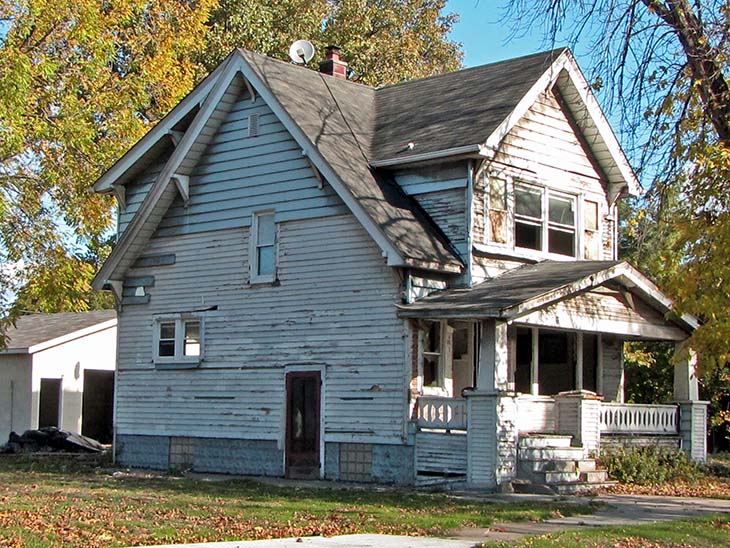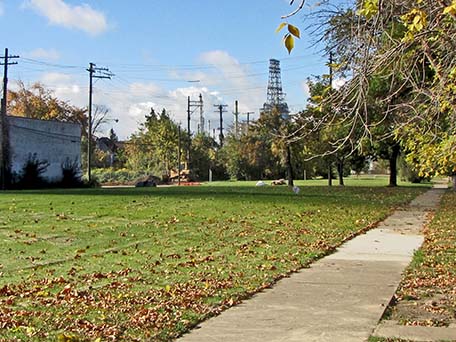

When David Bing became mayor of Detroit in 2010, it was obvious that the city faced severe challenges in paying for the municipal services needed by 714,000 spread across 139 square miles, an area that was home to about two million in the years just after World War II. Reducing fire, police and emergency services is very unpopular and difficult. Some urban planners suggested that Detroit needed to be downsized. Few were very explicit about what they meant. However, there was discussion that people living in very sparsely populated areas where many of the homes were derelict and abandoned should be encouraged to move to other more densely populated neighborhoods. Presumably, the city’s government could reduce or eliminate city services in the empty neighborhoods and concentrate them in the densely settled neighborhoods. No one laid out an explicit plan for this or offered cost estimates. And no one suggested forcing people out of their homes if they wished to remain.
Mayor Bing encouraged planners to think about downsizing the city. The Skillman Foundation supported an effort that considered the idea of downsizing, and in December, 2012, issued a long document about what Detroit might look like in the future, a comprehensive document entitled Detroit Future City: Detroit Strategic Framework Plan. Consideration was also given to a triage of Detroit neighborhoods. Some might be improved  with no more than a modest expansion of city services, some would need many more investments from the city and some were so devastated that further investments in infrastructure by the city seemed unwise. At one point, Mayor Bing declared that all city neighborhoods would get the same police, fire and emergency medical services but some neighborhoods would receive many more city investments than other neighborhoods when it came to repairing street lights, maintaining streets and parks.
with no more than a modest expansion of city services, some would need many more investments from the city and some were so devastated that further investments in infrastructure by the city seemed unwise. At one point, Mayor Bing declared that all city neighborhoods would get the same police, fire and emergency medical services but some neighborhoods would receive many more city investments than other neighborhoods when it came to repairing street lights, maintaining streets and parks.
All of this discussion became academic because the city’s finances deteriorated culminating in Governor Snyder appointing Kevyn Orr as Emergency Manager in March, 2013. Mayor Bing and Detroit’s Common Council lost their ability to make any financial decisions about the city. So far as I know, neither Emergency Manager Orr or federal bankruptcy Judge Rhodes ever described a downsizing of Detroit.
Oakwood Heights may be an example of the successful downsizing of a Detroit neighborhood. In 2010, the Marathon Oil Company announced that they would spend 1.9 billion dollars to modernize and expand their nearby refinery so that it could refine oil sands from Alberta that were transported to Detroit by the existing component of the Keystone pipeline. The renovation cost increased to 2.2 billion.
To the immediate north of the Marathon refinery was a major component of the Oakwood Heights Neighborhood. This included about 300 homes, most of them very modest workingmen’s homes built in the 1920s. There were a few more substantial brick homes but there were, quite likely, almost no architect designed homes in Oakwood Heights.
Many environmentalists opposed the expansion of the Marathon refinery since they feared that the volume of pollution would increase even through the plant had satisfied federal regulations. Data were assembled by an environmental group at the University of Michigan showing that zip-code area 48217—the one that includes Oakwood Heights—was the least healthy such area in the state of Michigan.
Marathon Oil, in November 2011, announced an Oakwood Heights Property Purchase Program for the area to the immediate northeast of their plant, an area bounded roughly by Sanders, South Oakwood Boulevard, the River Rouge and South Dix Street. There were 294 homes in this neighborhood with a total population of approximately 1,200. The average assessed value of a home here was about $16,000. Home owners were offered $40,000 plus 50 percent of the assessed value of their proper ty. Owners of rental properties were offered $30,000 plus 30 percent of the assessed value. If their rental property were sold, the renter was given $3,000. I have heard rumors that some owners turned down Marathon’s offer and then bargained for a larger payment, but I cannot confirm that. I have also heard that Marathon provided relocation assistance but I know of no study of what happened to the people who accepted or rejected Marathon’s downsizing efforts.
ty. Owners of rental properties were offered $30,000 plus 30 percent of the assessed value. If their rental property were sold, the renter was given $3,000. I have heard rumors that some owners turned down Marathon’s offer and then bargained for a larger payment, but I cannot confirm that. I have also heard that Marathon provided relocation assistance but I know of no study of what happened to the people who accepted or rejected Marathon’s downsizing efforts.
By early 2014, 239 of the homes were sold to Marathon and the owners of another 26 were still in negotiation. This means that 10 percent of the home owners turned down the Marathon offer, although some of them may be speculators who think that Marathon will eventually offer much more for the final few homes. Marathon has not, so far as I know, announced any plans for this area. Presumably, it will become a green buffer zone. Many of the homes they purchased were promptly razed and the land planted with grass. Marathon cannot use eminent domain to purchase the remaining homes so, I presume, the city of Detroit will have to provide services to a small number of residential units in this neighborhood.
What does the Oakwood Heights Property Purchase Program tells us about downsizing Detroit? It suggests that it is possible to get a very high proportion of people to leave a neighborhood but the cost would be substantial. Presumably, the typical owner got about $48,000 dollars for a home that had a market value of about $16,000. I presume that Marathon had to spend about 15 to 17 million dollars to purchase the homes they obtained, suggesting that downsizing efforts in other Detroit neighborhoods will be very costly. And it also suggests that even when owners are offered a great deal more than their homes are worth, a fraction of them will remain.
Use in 2014: You might call this an empty neighborhood that primarily serves as a buffer zone for the Marathon refinery but there are some occupied homes.
Detroit Free Press description: http://www.freep.com/apps/pbcs.dll/article?AID=2014302160053
City of Detroit Designated Historic District: Not listed
State of Michigan Registry of Historic Sites: Not listed
National Register of Historic Places: Not listed
Pictures: Ren Farley; Summer 2013
Description prepared: February, 2014
Return to Multi-Family Housing
Return to Homepage